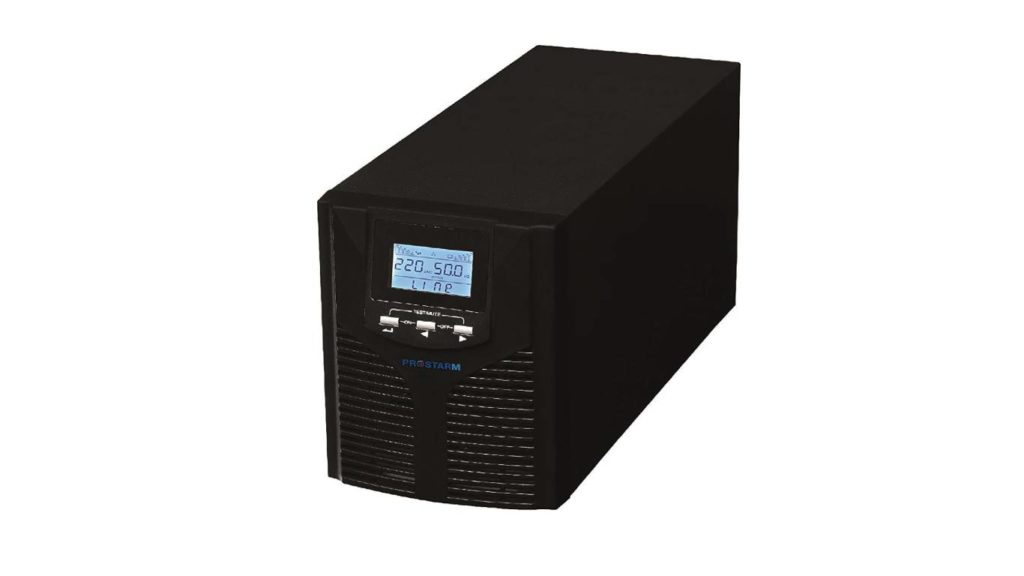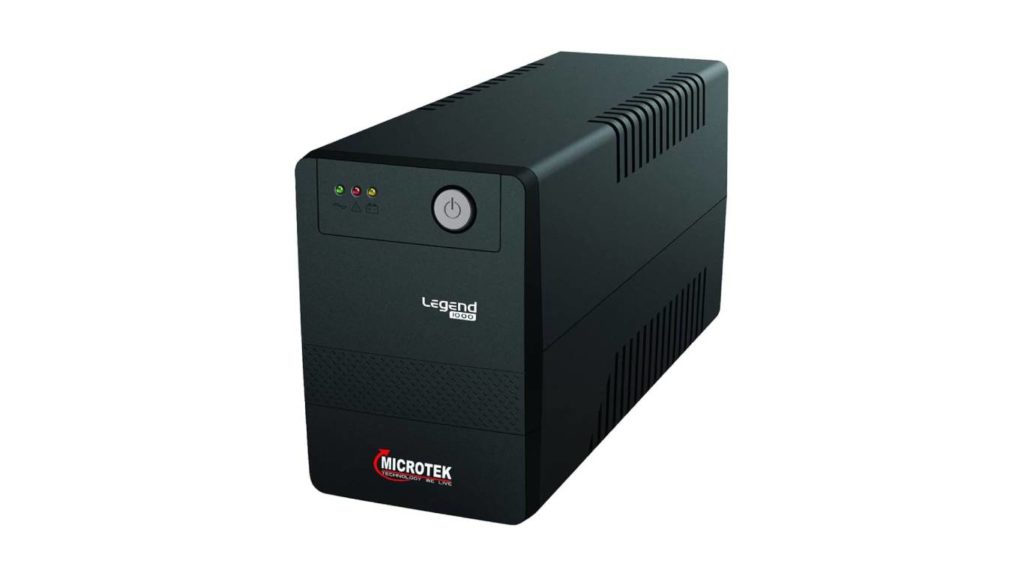
UPS, which stands for an uninterruptible power source or an uninterruptible power supply, is pivotal in modern systems. It acts as a precaution against power outages, voltage fluctuations, and power surges, usually due to faulty installations or natural disasters such as thunderstorms. It prevents any consequent damage, whether physical, such as equipment and infrastructure, or digital, like invaluable data stored on computers. Even home users without costly gear and electronics will benefit from UPS, because, as they say, an ounce of prevention is worth a pound of cure. With that in mind, let’s explore different types of UPS.
What is a UPS?
An uninterruptible power supply is a device that provides backup power to a system, ensuring stable functioning, at least for some time, during which one can shut down a computer safely. In the case of an electricity outage, a UPS can be crucial, as it can save your work from being lost due to a sudden shutdown. UPSs excel at protecting hardware and not only computers, as they are extensively used in data centers, telecommunications, and even other electronic devices.
There are different types of UPS, which range in size, power supply, and even life cycle; however, they all work on a similar principle, which is discussed in the following video:
Types of UPS
There are many types of UPS you can use on a daily basis. Not all of them are worth your hard-earned money. To help you out, after trying tens of UPS products, we have concluded with a list.
1. Online or double conversion UPS

Double conversion/online uninterruptible power supply got its name because it converts the incoming AC (alternate current), such as from an outlet to DC (direct current) and back to AC. In doing so, this type of UPS delivers stable, clean, continuous, high-quality AC to equipment and infrastructure.
Because of its impeccable efficiency when it comes to eliminating voltage spikes, sags, or breakdown of the system, only this one among all types of UPS is suitable for mission-critical data or equipment.
In other words, online UPS is used in systems where even minute disturbances pose a risk. That’s because it can eradicate even subtle waveform distortion and nuanced harmonics. Case in point, looking at the output via an oscilloscope shows an ideal sine wave. This illustrates that it also regenerates the electrical sine wave, Whereas, other forms of UPS leave it alone and only treat the raw power supply.
Unfortunately, the nearly perfect output performance means uninterrupted wear and tear on the components, reducing their durability and life cycle.
How does an online UPS work?
Online uninterruptible power source uses a rectifier and an inverter to convert AC to DC and power the battery and the corresponding load. As the primary power source is always connected to the DC to AC converter, no transfer switches are required. Additionally, if the AC output ever fails, the rectifier will drop within the circuit, allowing the power from the battery to power the UPS. Once input resumes, the rectifier takes the brunt of the load and starts filling up the battery.
Use cases
Don’t fret if you aren’t familiar with this representative of UPS types or haven’t considered it for home use. It is dominant in systems where the power range exceeds 10 kVA, which yours likely doesn’t. Moreover, it’s the most expensive of the three. Thus, online/double-conversion UPS is typically only used for server rooms and data centers, where files of utmost importance are stored.
2. Offline or standby UPS

Standby or offline UPS, also known as battery backup, is an example you likely recognize. It’s the most basic of them all and a cost-effective choice for personal use or individual power outlets in small businesses. Common use cases include desktop and laptop computers, workstations, network equipment, consoles, and non-stop printing machines.
In fact, any costly electronics prone to damage from a power outage or voltage fluctuations is an ideal candidate. However, this UPS technology is widely used only for a power draw of below 1500 VA or 1.5 kVA.
The functionality of standby UPS
Although you get what you pay for, that seems to be sufficient for most typical problems. Standby uninterruptible power supply is efficient against nearly 90% of all power outages. It can balance out spikes in power by bringing down the voltage to optimal levels.
Unlike online UPS, it doesn’t react instantly. Instead, it has a 6 to 20-millisecond delay before it starts using power from the power backup. That’s because it has a transfer switch, which, when power gets cut, activates the inverter to convert DC to AC and connects the battery to the output.
Practical application
Offline UPS is not suitable for all applications, though. First, you must consider its inability to ride out prolonged power outages. It can only supply a limited amount of power. In other words, it can only last long enough for users to safely save what they are working on, or turn off the machine/equipment.
Unfortunately, it fails at voltage regulation, as surges and power sags can go straight to the main load. Also, it has no failsafe in cases of an excessive starting current, voltage overload, or invertor breakdown. If that happens, it may pass the entire load to the equipment, rendering its use meaningless.
3. Line-interactive UPS

Line-interactive UPS represents a middle ground between the online and offline UPS, both in price and functionality. It’s a low-cost solution for handling voltage fluctuations, both under and over, of around 20%. To provide conditioned power, a line-interactive uninterruptible power supply requires a multi-tap autotransformer with variable voltage or a buck-boost converter.
Another great thing is that it neither uses battery power during normal operation nor under minimal variations in voltage. It is only when the fluctuations skyrocket that battery power kicks in. Finally, it’s power-efficient and silent during operation.
How does line-interactive UPS function?
We explained what makes it unique and in demand. As for the way it works, it’s similar to offline UP. It uses a transfer switch, so it has the same delay before it kicks in. This time it’s a tad shorter, usually 4 to 6 milliseconds. Likewise, it has an inverter that converts AC to DC and vice-versa to enable the battery to charge/supply power.
The only difference is that AC power from the outlet passes through a voltage regulator. For the reasons we mentioned, the inverter never stops working, unlike in offline UPS. This can reduce its lifespan substantially. Moreover, its normal operation tends to drain the battery more often than online UPS, requiring more frequent maintenance or replacement.
Where is it used?
Line-interactive UPS is one of the UPS types commonly employed anywhere power requirements don’t exceed 5000 VA or 5 kVA. Some examples include small businesses, small data centers, and corporate or web servers. That’s because it’s more affordable than an online UPS, yet shields against voltage inconsistencies better than offline UPS. It’s a happy medium between realistic protection needs and high operating costs.
Comparison between the 3 types of UPS
The following table is a comparison between the three types of UPS we have mentioned here:
| Features | Online UPS | Line-Interactive UPS | Offline UPS |
| Efficiency | Very High | Above average | Average |
| Protection | Versatile, as it can protect against advanced voltage fluctuations | It has moderate protection | Offers only a basic level of protection against power surges |
| Backup | No interruptions | Depends on the battery | Very short, mostly a few minutes |
| Cost | Very costly | Affordable but on the higher side | Very affordable |
| Use cases | Industrial use | Can server small or medium servers | Personal or home use |
Our Survey of UPS Users
We ran a survey among our users to know why they are using UPS and what kind. Here are the results. It might help you to pick the right one for you.
- Reasons for Using UPS: Our survey found that 45% of respondents use UPS for safeguarding their workstations during power outages. Meanwhile, 30% use it to protect sensitive home electronics, and the remaining 25% rely on UPS systems for consistent power supply to critical medical or industrial equipment.
- Preferred UPS Types: 60% endorsed Line-Interactive UPS units due to their optimal balance between cost and functionality. The double-conversion Online UPS was the choice of 25%, valued for its superior power protection, while Standby UPS units commanded a 15% share, favored for their affordability and simplicity.
- Brand Preferences: APC emerged as the preferred brand for 40% of users. CyberPower followed with 30% preference, praised for its innovative features and price point. Eaton (20%) was noted for its durability and customer service, while Tripp Lite (10%) was appreciated for its compact designs.
- Future Considerations: In terms of future purchases, 70% of participants expressed considering a higher capacity model, citing increased usage of electronic devices. On the other hand, 20% were keen on exploring smart, IoT-enabled UPS systems for enhanced remote monitoring and control capabilities.
What is new for UPS?
Although UPS has been around for quite some time now, new technological trends for the sector are now making waves, allowing more and more people to access it. If the Precedence Research report is to be believed, the market for USPs will grow substantially over this decade to reach $13.16 billion from the current $9 billion. And that is after factoring in the severe effect on the industry due to the Russia-Ukraine war and the recent COVID pandemic.
Having said that, let us explore what’s new in the sector:
1) Remote monitoring
The most amazing advancement in recent UPS history is certainly the implementation of remote monitoring. It allows systems to automatically examine any potential issues and then forward the report to a monitoring center. There, the issues can be analyzed remotely and, if needed, action taken, thus saving the UPS from failing at a crucial time.
2) Smaller sizes
Another important improvement is that UPS has become compact. It is no longer limited to huge corporations but also to small-scale industries, as it can be installed in tight spaces. Furthermore, the introduction and improvement of IGBT, or insulated-gate bipolar transistor, technology has allowed manufacturers to create much smaller UPS with faster and more powerful capabilities while at the same time costing less.
3) The new Mechanical-energy flywheel technology
The new generation of UPS is most likely to use the recent mechanical-energy flywheel technology. It’s a step forward in energy storage, as the technology slows down the rotor after making it spin at maximum rotation and drawing energy. Doing so reduces energy consumption. The technology is all set to replace the traditional lead-acid batteries, allowing UPS to store more energy. It is also good for the environment.
How to choose the perfect UPS for your system?
If you are looking for an optimal UPS for your system, then worry not, as we are here to guide you through some of the steps you should take to ensure the best solution for your device.
1. Know your needs
Before purchasing any UPS or other similar solution, you should first be sure about your needs, such as the total load of the system that requires protection. Everything else can come later.
2. Check the UPS run time and make sure it is enough
There are different types of UPS on the market, offering various runtimes. Sometimes a UPS backup can only last a few minutes. If you know how much time is enough for you to safely shut down the system, you can look for a UPS in the same range.
3. Number of devices to be connected
You should also consider the number of devices you want to connect to a UPS. A UPS has limited outlets, and it can’t connect every device you have. If you want a solution for your PC, then the UPS should at least have two outlets, one for the monitor and the other for the CPU.